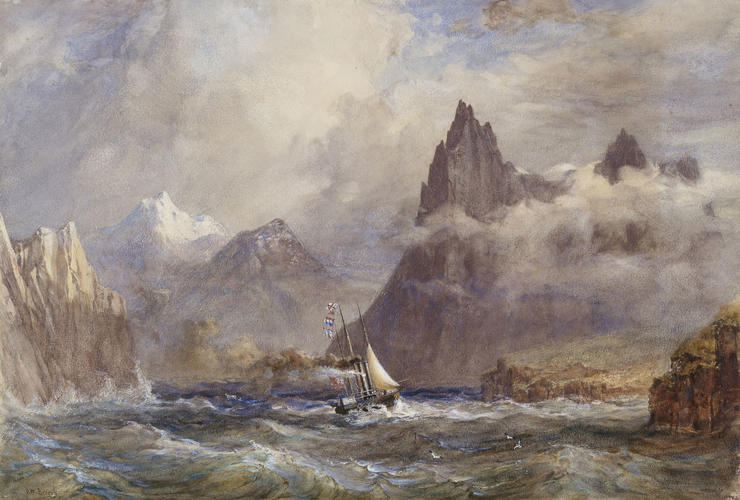Sir Oswald Walters Brierly (1817-94)
The Lofoten Islands 1864
Watercolour and bodycolour over pencil, with some scratching out | 32.1 x 47.0 cm (sheet of paper) | RCIN 925417
-
A watercolour showing Prince Alfred and the Duke of Roxburghe sailing up the fjords in the paddle-ship Black Eagle to visit the Lofoten islands in Norway.
Brierly studied navigation and naval architecture at Plymouth, and in 1841 began a voyage around the world as staff artist on Benjamin Boyd's ship The Wanderer. On reaching Australia he settled in New South Wales, developing a mining business and taking part in several Admiralty surveys. Brierly journeyed back to England in 1851-3, serving with the Baltic fleet and as a war artist for The Illustrated London News in the Crimea. His first work for Queen Victoria was to record the Naval Review at Spithead in 1856, and he worked intermittently for the Queen and her elder sons for the next thirty years.
Queen Victoria's second son, Alfred, Duke of Edinburgh (1844-1900), had joined the navy in 1858, serving as a cadet and midshipman before being appointed as lieutenant on the 22-gun steam corvette HMS Racoon in 1863, under Captain Count Gleichen. In the summer of 1864 the Racoon, together with HMS Euryalus and Black Eagle, went on a tour of duty to Norway, and Brierly accompanied Prince Alfred to record the voyage. The Duke's duties appear not to have been too arduous. The furthest point of the tour, the Altafjord just south of Hammerfest on the northern tip of Norway, was the summer fishing quarters of the sixth Duke of Roxburghe and reputed to be the finest salmon waters in the world; Prince Alfred caught forty salmon totalling 563 pounds [255 kg] in three and a half days' fishing, and the Duke of Roxburghe then joined the Prince on the voyage back down the coast to Bergen. On 19 August they explored the inlets of the Lofoten Islands, an archipelago in the Arctic Ocean on the north-west coast of Norway, in the . Brierly here depicted the paddle-steamer in a heavy sea returning to open water.
Catalogue entry from Royal Treasures, A Golden Jubilee Celebration, London 2002Provenance
Painted for Alfred, Duke of Edinburgh
-
Medium and techniques
Watercolour and bodycolour over pencil, with some scratching out
Measurements
32.1 x 47.0 cm (sheet of paper)
Object type(s)
Other number(s)
RL 25417








